|
Displaying items by tag: technique
As a technique for creating art, frottage is so closely identified with Surrealism, in general, and Max Ernst, in particular, that the link itself might be an example of the technique.
"Frottage" is French for "rubbing," and it rubbed off on the boisterous Surrealist movement that in the troubled decades between the two World Wars was dedicated to unleashing the creative potential of the unconscious mind. When a sheet of paper is laid over a textured surface and rubbed with pencil or pastel, unexpected and evocative shapes, forms and tonalities can be produced.
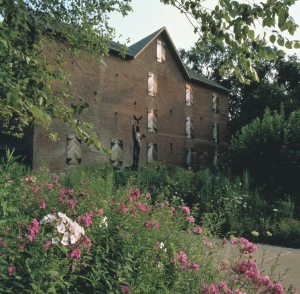
At a press reception held Jan. 16 prior to the opening of the Brandywine River Museum of Art’s major retrospective of Jamie Wyeth’s work, Jamie Wyeth repeatedly expressed his unease at “revisiting his early work.” He said that he knew he “grew from his early work” but that it “doesn’t interest him” to see it now. While he may express such sentiments, those attending the exhibition will find much to fascinate and engage them as they follow his development as an artist. The exciting exhibition on the walls of the Brandywine galleries which have been painted in handsome hues of burgundy and maroon to complement the paintings, examines his distinctive approach to realism over the course of six decades, from his earliest portraits to the present. Landscapes of the Brandywine Valley and coastal Maine, family members and fellow artists (including the engaging portrait of Andy Warhol painted in 1976, whom he described as “very childlike”), are shown as well as domesticated and wild animals, many executed in “combined mediums,” the term he uses to describe his technique.
Gustave Courbet, who was born on June 10, 1819, in Ornans in the Franche-Comté region of eastern France and died December 31, 1877, in La Tour-de-Peilz on Lake Geneva, counts among the most important forerunners of classic modernism. His self-confident demeanor, the emphasis he placed upon his individuality as an artist, his inclination towards provocation and breaking taboos, not to mention his revolutionary painting technique, were to set standards that have influenced generations of artists. The exhibition at the Fondation Beyeler is the first dedicated to Gustave Courbet in Switzerland for over fifteen years.
The show presents pioneering works from all phases of the artist’s career, including a number of paintings that have rarely been seen in public or which indeed for many decades were not publicly accessible at all.
A documentary about the Dutch painter Johannes Vermeer (1632-1675) has been acquired for distribution by Sony Pictures Classics. Tim’s Vermeer, which was directed by Teller of the illusionist duo Penn & Teller, features Tim Jenison, a Texas-based inventor who explores how Vermeer created his shockingly photo-realistic paintings a century before photography existed.
At one point during his ten-year investigation, Jenison traveled to Delft, Holland, where Vermeer worked, to meet with the British artist David Hockney, who had also questioned how Vermeer and his contemporaries created their breathtakingly realistic paintings. Using 17th century technology such as lenses and mirrors, Jenison eventually figured out the technique used by the Dutch master “supporting a theory as extraordinary as what he discovers,” Sony Pictures Classics said in a news release.
Sony Pictures Classics will release Tim’s Vermeer in 2014.
The Cleveland Museum of Art acquired a rare enamel-on-copper copy of Titian’s (1485-1576) iconic 16th century masterpiece Bacchus and Ariadne by the English enamel painter Henry Bone (1755-1834). The museum purchased the 19th century work at Christie’s London on July 4, 2013 for $478,346. Curator John Seydl made the winning bid over the telephone from a London hotel in an effort to disguise the museum’s interest from other bidders.
The enamel measures 16 inches by 18 inches, which is exceptionally large for the medium typically used to execute portrait miniatures. The work includes an ornate gilt-wood and gesso frame and serves as a prime example of Bone’s innovative and widely admired enamel technique.
After being shipping to Cleveland, the Titian copy is expected to hang in the museum’s early 19th century gallery, which features French and English art.
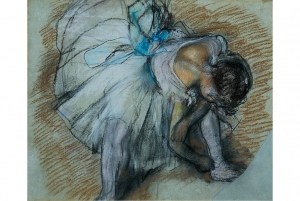
49 paintings from the Dixon Gallery and Gardens in Memphis, TN are now on view at the Joslyn Art Museum in Omaha, NE. Renoir to Chagall: Paris and the Allure of Color focuses on Paris’ emergence as the hub of the art world during the 19th century and its role in shaping the Impressionist movement in France.
Between 1853 and 1870, under the command of Napoleon III, Paris was transformed from a quaint city to one of grandeur. Narrow streets and crowded houses were demolished in favor of striking boulevards, lush public gardens, and modern buildings. While the population and prosperity of the city soared, artists flocked to Paris to be inspired and thrive, ultimately defining the city’s modern era. Camille Pissarro (1830-1903), Alfred Sisley (1839-1899), Claude Monet (1840-1926), Pierre Auguste Renoir (1885-1952), and Edgar Degas (1834-1917) all nurtured their artistic visions in Paris during this period. In 1874, the artists held an independent exhibition, which led to their classification by critics as Impressionists. The plein air technique and unblended painterly style of Impressionism eventually influenced future generations of avant-garde artists include Neo-Impressionists, Fauves and Cubists.
The museum’s founders, Hugo and Margaret Dixon, formed the institution’s magnificent collection of French paintings themselves. John Reward, a leading scholar of Impressionism, advised the couple. Renoir to Chagall offers the finest works from their holdings and is on view at the Joselyn Art Museum through September 1, 2013. Admission to the museum and exhibition is free.
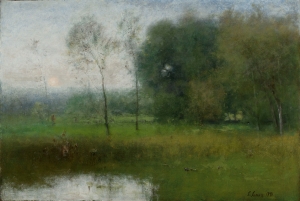
The Sterling and Francine Clark Institute in Williamstown, MA recently received its most considerable gift of American paintings since its founding in 1955 and is holding an exhibition to celebrate the major acquisition. George Inness: Gifts from Frank and Katherine Martucci presents eight landscapes by the influential American painter George Inness (1825-1894) dating from 1880 to 1894. The works will appear alongside two Inness paintings collected by the Clarks themselves. The show will highlight Inness’ later work when he moved away from his signature plein-air style towards a more conceptual aesthetic that relied on the use of light and shadow.
The Swedish philosopher Emanuel Swedenborg significantly influenced Inness and inspired the artist to look at nature through a more spiritual lens. Inness moved away from straightforward depictions of the natural world towards a style that blended realism with a sense of otherworldliness. Inness achieved this through color, composition and painterly techniques that involved the gentle blurring of natural forms.
Highlights from the exhibition include Sunrise in the Woods, The Road to the Village, and Green Landscape. George Inness: Gifts from Frank and Katherine Martucci will be on view through September 8, 2013.

Henri Matisse: La Gerbe is currently on view at the Los Angeles County Museum of Art and highlights the artist’s final commissioned work. Henri Matisse (1869-1954) created La Gerbe (The Sheaf), a 2,000 lb., 18 x 20-foot ceramic piece, in 1952 for the home of Los Angeles-based philanthropists Sidney and Frances Brody. Mrs. Brody promised the work to LACMA in honor of the museum’s 25th anniversary and donated it to the institution in 2010. This event marks the first time that La Gerbe has been displayed alongside its full-scale maquette, which is on loan from the University of California’s Hammer Museum.
Late in his career, Matisse developed his cut-out technique, which involved cutting organic shapes out of colored paper and arranging them on his studio’s walls. Giving the artist a renewed sense of freedom, Matisse lauded the technique for its immediacy and simplicity, which he believed helped him express his artistic urgencies more completely.
When he received the commission from the Brody’s, Matisse created a full-scale paper cut-out of his design, which he showed the couple during their visit to his studio in Nice, France. The Brody’s rejected the first design but accepted a second full-scale cut-out, which is the maquette included in LACMA’s exhibition. The final La Gerbe was executed in ceramic and consisted of 15 sections, which were shipped to Los Angeles in 1954 following the artist’s death. The work was installed on the Body’s patio wall where it remained until Frances’ death in 2009. The work was permanently installed at LACMA in 2010.
LACMA’s exhibition includes other major works from Matisse’s cut-out period including Madame de Pompadour (1951) and Jazz (1947), a historic book of 20 prints, which is considered the artists’ first major project using the cut-out technique.
The La Gerbe exhibition will be on view at LACMA through September 8, 2013.
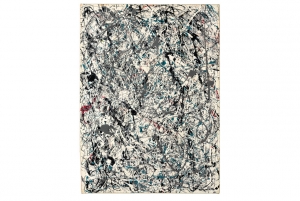
Christie’s will present a seminal painting by Jackson Pollock (1912-1956) during their Contemporary Art Evening Auction on May 15, 2013. Created during Pollock’s most important artistic period, Number 19 (1948) is the most significant painting by the artist to appear at auction in 20 years.
One of Pollock’s famous drip paintings, Number 19 features layer upon layer of swirling silver, black, and white paint punctuated by pops of red and green. The movement of the paint mimics the movement of Pollock’s hand, creating a unique connection between the artist and the viewer.
From 1947 to 1950 Pollock was exceptionally prolific as an artist. It was during this time that he revolutionized abstract painting with his gestural drip paintings. 1948 is considered the year that Pollock truly mastered the technique, exhibiting more control over the thinned enamel paint he poured and dripped onto unprimed surfaces.
Number 19, which is an exemplary work from this remarkable period in Pollock’s career, is expected to garner anywhere form $25 million to $35 million at auction.
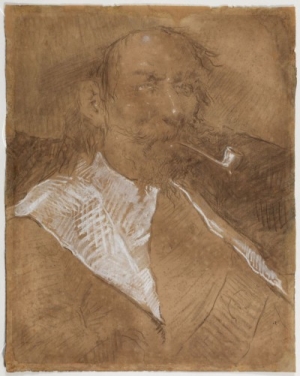
Staff members at the Picasso Museum in Barcelona, Spain discovered an early portrait by Pablo Picasso (1881-1973) while restoring a different work by the 20th century Spanish artist. Workers removed the cardboard backing on Portrait of the Artist’s Mother (1896), which was executed by a 15-year-old Picasso, revealing a charcoal drawing of a man with a pipe.
Reyes Jimenez, head of restoration at the Picasso Museum, believes that the charcoal work is older than the portrait of the artist’s mother. The charcoal drawing is an important piece because it illustrates Picasso’s artistic tenacity as well as his mastery of challenging techniques from a young age. The newly discovered drawing suggests that Picasso’s early knowledge was greater than previously believed.
The Picasso Museum, which opened to the public in 1963, houses one of the most extensive collections of artworks by Picasso. It was the first museum dedicated solely to the work of Picasso and the only one created during the artist’s lifetime.
|
|
|
|
|